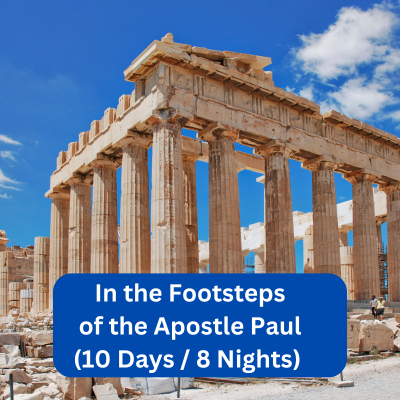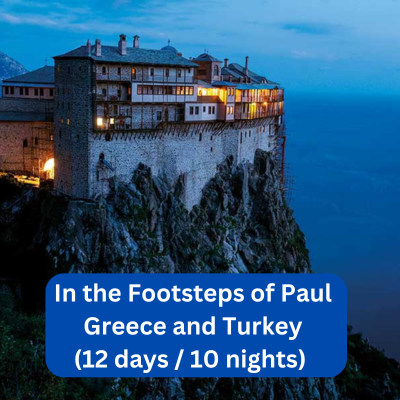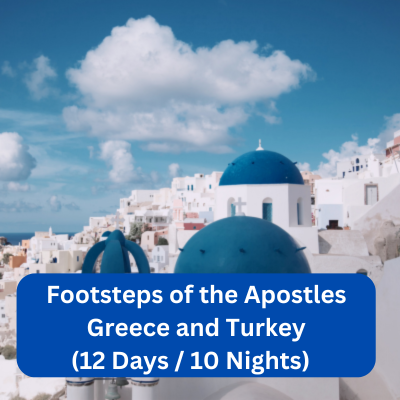Top 10 Tourist Destinations in Greece
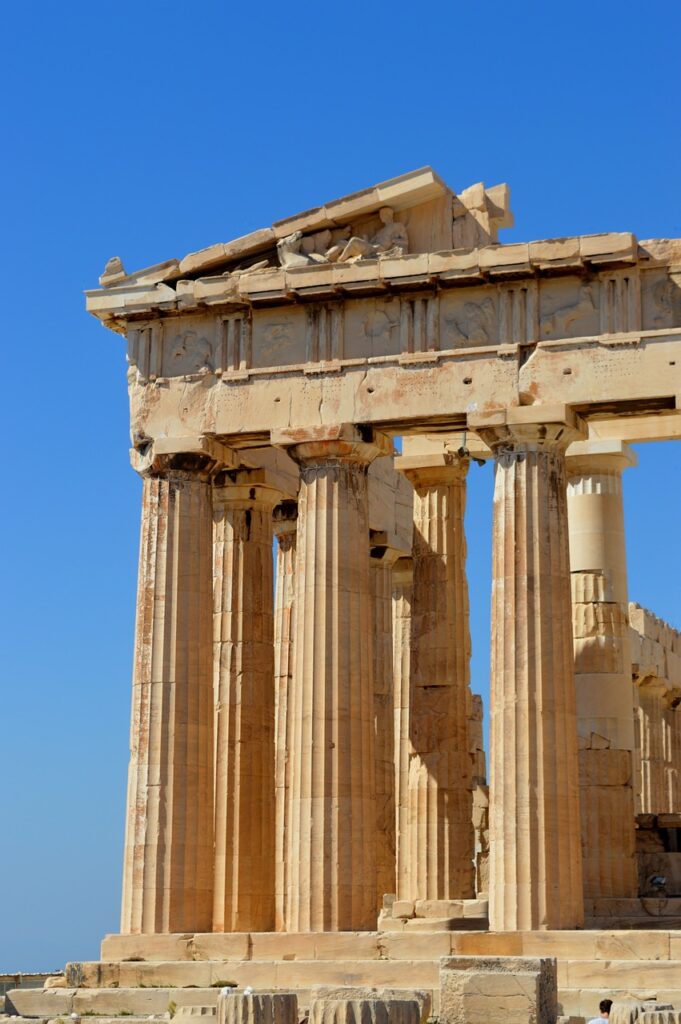
1. Athens
Athens, the capital city of Greece, is a historical and cultural treasure trove, blending ancient heritage with modern vibrancy. The city is dominated by the Acropolis, a UNESCO World Heritage site that houses the iconic Parthenon, a symbol of ancient Greece and democracy. Visitors can explore the Ancient Agora, where philosophers like Socrates once walked, and the National Archaeological Museum, which boasts one of the richest collections of Greek antiquities in the world. The Temple of Olympian Zeus and the Panathenaic Stadium, which hosted the first modern Olympic Games in 1896, are also must-see historical landmarks.
The vibrant neighborhoods of Plaka and Monastiraki, with their narrow streets, traditional taverns, and lively markets, offer a glimpse into the city’s vibrant contemporary culture. Syntagma Square, the heart of modern Athens, is home to the Greek Parliament and the ceremonial changing of the guard at the Tomb of the Unknown Soldier. Athens also boasts a thriving arts scene, with numerous galleries, theaters, and cultural events throughout the year.
Modern attractions include the Stavros Niarchos Foundation Cultural Center, a modern architectural marvel that houses the National Library and the Greek National Opera. Athens seamlessly blends ancient history with modern life, making it a must-visit destination for history enthusiasts, urban explorers, and culture seekers alike.
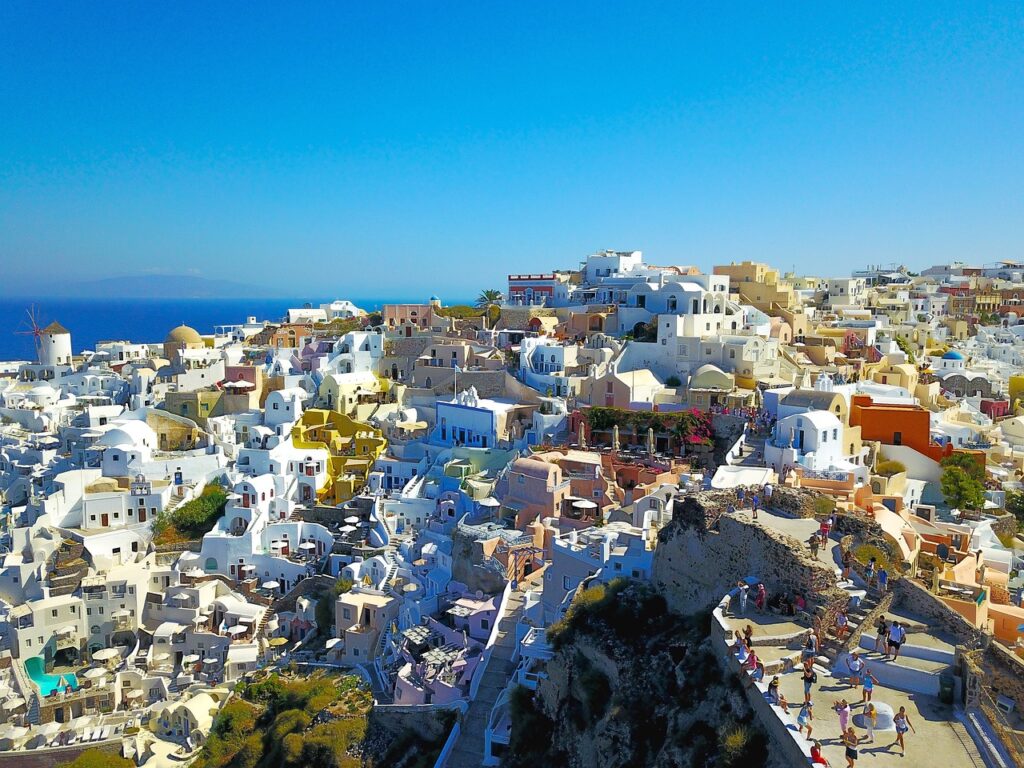
2. Santorini
Santorini is world-renowned for its stunning sunsets, white-washed buildings, and blue-domed churches that dot the cliffs of its caldera. Formed by a volcanic eruption, the island’s unique landscape is both dramatic and serene. The towns of Fira and Oia offer breathtaking views over the Aegean Sea, and the narrow cobblestone streets are lined with charming shops, cafes, and restaurants. Santorini’s volcanic beaches, such as the Red Beach and Kamari Beach, provide a unique setting for relaxation.
The island’s rich history can be explored at the ancient ruins of Akrotiri, a Minoan Bronze Age settlement preserved in volcanic ash, often referred to as the “Minoan Pompeii.” The Museum of Prehistoric Thera in Fira houses artifacts from Akrotiri, offering insights into the island’s ancient past. Santorini is also famous for its excellent wineries, where visitors can sample local wines like Assyrtiko while enjoying panoramic views of the vineyards and the caldera.
Santorini’s combination of natural beauty, luxurious accommodations, and rich history make it a premier destination for travelers seeking romance, adventure, and a touch of ancient mystery. The island’s vibrant nightlife and culinary scene, featuring fresh seafood and local delicacies, further enhance its appeal.
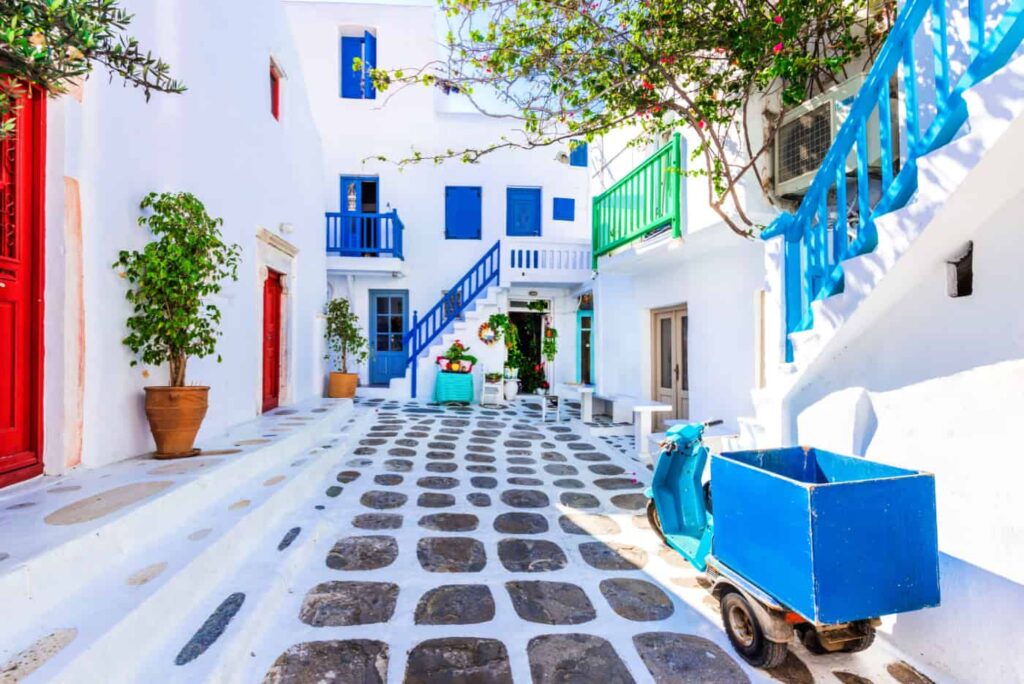
3. Mykonos
Mykonos is known for its vibrant nightlife, beautiful beaches, and picturesque Cycladic architecture. The town of Mykonos, also known as Chora, is famous for its iconic windmills and the charming area of Little Venice, where buildings are right on the water’s edge. The labyrinthine streets are filled with boutique shops, art galleries, and upscale restaurants, creating a bustling yet chic atmosphere.
By day, visitors can relax on renowned beaches like Paradise and Super Paradise, known for their lively beach clubs and clear turquoise waters. Other popular beaches include Psarou, Ornos, and Elia, each offering a unique vibe and range of amenities. At night, Mykonos transforms into a bustling party destination with world-class DJs and clubs like Cavo Paradiso and Scorpios, attracting a glamorous international crowd.
Despite its reputation for nightlife, Mykonos also offers cultural experiences. The Church of Panagia Paraportiani, one of the most photographed churches in Greece, and the nearby island of Delos, an important archaeological site and the mythological birthplace of Apollo and Artemis, provide a rich historical context. Mykonos provides a perfect blend of relaxation, cultural exploration, and excitement, attracting visitors from around the globe

4. Crete
Crete, the largest of the Greek islands, is a land of diverse landscapes and rich history. The island’s archaeological treasures include the Palace of Knossos near Heraklion, the center of the ancient Minoan civilization and one of the most significant archaeological sites in Greece. This palace complex, with its intricate frescoes and labyrinthine corridors, offers a fascinating glimpse into ancient life and mythology.
Crete’s natural beauty is equally captivating. The island is home to stunning gorges, such as the Samaria Gorge, one of Europe’s longest, and pristine beaches like Elafonissi, known for its pink sand, and Balos, with its turquoise waters. The old town of Chania, with its Venetian harbor, narrow alleys, and historic buildings, offers a charming glimpse into the island’s past, blending Venetian, Turkish, and Greek influences.
Rethymno, with its well-preserved Renaissance architecture, and the traditional villages scattered throughout the island, provide further cultural immersion. Visitors can also explore the island’s rich culinary heritage, sampling local specialties like dakos, a traditional Cretan salad, and lamb with stamnagathi, a wild green. Crete’s warm hospitality, delicious cuisine, and its blend of history, culture, and natural beauty make it a must-visit destination.

5. Rhodes
Rhodes, the largest of the Dodecanese islands, is known for its medieval old town, a UNESCO World Heritage site. The town is a maze of cobbled streets, historic buildings, and ancient ruins, with the impressive Palace of the Grand Master standing as a testament to its past as a stronghold of the Knights of St. John. This medieval fortress, with its imposing towers and thick walls, offers a fascinating journey through history.
Beyond the old town, Rhodes offers beautiful beaches and crystal-clear waters. The ancient city of Kamiros, one of the three ancient cities of Rhodes, and the picturesque village of Lindos, with its acropolis and stunning views, are key attractions. Lindos’ narrow streets, whitewashed houses, and the impressive Lindos Acropolis overlooking the sea create a postcard-perfect scene.
Rhodes also boasts a lively modern culture, with numerous restaurants, cafes, and shops. The island’s vibrant nightlife, particularly in the area of Faliraki, attracts visitors looking for entertainment and relaxation. Whether exploring ancient ruins, relaxing on pristine beaches, or enjoying the vibrant nightlife, Rhodes offers a diverse array of experiences for visitors, making it a top destination in Greece.

6. Delphi
Delphi, once considered the center of the world in ancient Greek religion, is one of Greece’s most significant archaeological sites. Nestled on the slopes of Mount Parnassus, Delphi was home to the Oracle of Delphi, where the priestess Pythia delivered prophecies to those seeking guidance. Visitors can explore the ruins of the Temple of Apollo, the ancient theater, and the stadium, all set against a stunning mountainous backdrop.
The Delphi Archaeological Museum houses an impressive collection of artifacts, including the famous Charioteer of Delphi statue, offering insights into the site’s historical and cultural significance. The Sacred Way, a path lined with the remains of ancient treasuries and statues, leads up to the Temple of Apollo, providing a sense of the grandeur that once characterized this sacred place.
Delphi’s historical and spiritual significance, combined with its breathtaking natural setting, makes it a must-visit destination for those interested in ancient Greek history and mythology. The nearby village of Arachova offers charming accommodations, traditional tavernas, and shops selling local crafts and delicacies, providing a perfect base for exploring the region. Delphi’s blend of history, spirituality, and natural beauty offers a profound and enriching travel experience.

7. Meteora
Meteora is renowned for its monasteries perched atop towering rock formations, creating a dramatic and awe-inspiring landscape. This UNESCO World Heritage site is home to six active monasteries, which were built by monks seeking solitude and spiritual elevation. The monasteries, such as Great Meteoron and Varlaam, are accessible by footpaths and steps carved into the rocks. Inside, visitors can admire exquisite frescoes, icons, and ancient manuscripts.
The combination of natural beauty and human ingenuity at Meteora offers a unique spiritual experience. Hiking trails and observation points provide stunning views of the monasteries and the surrounding valleys, making Meteora a captivating destination for both spiritual seekers and nature enthusiasts. The town of Kalambaka, located at the base of the rock formations, serves as a gateway to Meteora, offering accommodations, restaurants, and amenities for visitors.
Meteora’s unique landscape, with its towering cliffs and serene monasteries, provides an ideal setting for reflection and exploration. The site’s history, spirituality, and breathtaking scenery make it one of Greece’s most memorable and inspiring destinations.
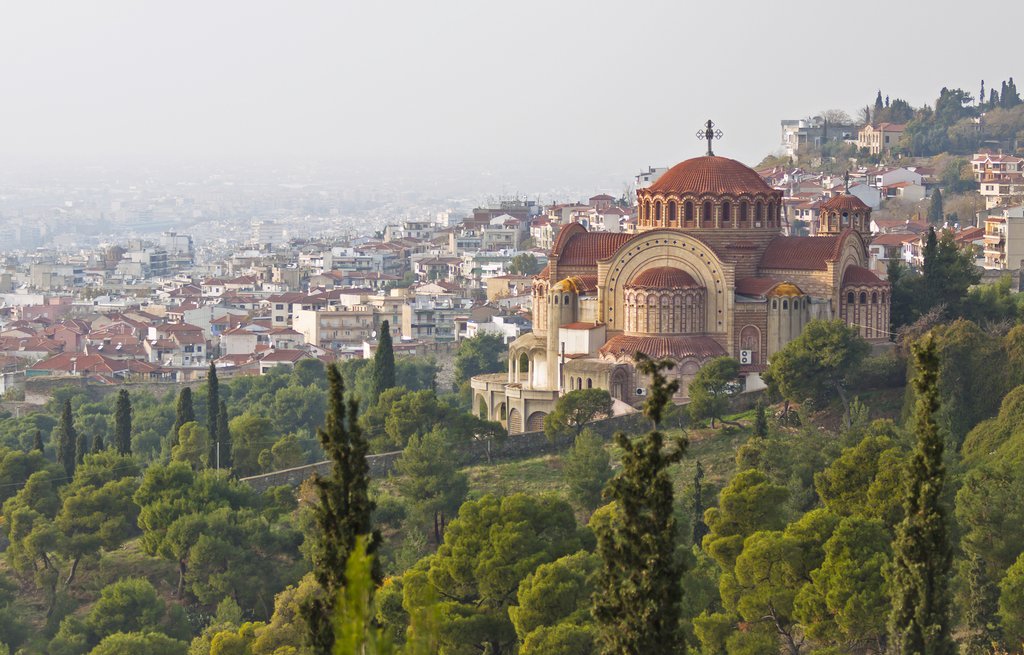
8. Thessaloniki
Thessaloniki, Greece’s second-largest city, is known for its rich history, vibrant culture, and youthful energy. The city’s waterfront is a lively area perfect for strolls, with landmarks such as the White Tower offering panoramic views of the city and the sea. Thessaloniki is also home to impressive Byzantine churches, including the Rotunda and Hagia Sophia, showcasing stunning mosaics and architecture.
The Archaeological Museum and the Museum of Byzantine Culture offer insights into the city’s ancient and medieval past. Thessaloniki’s bustling markets, such as Modiano Market, and its diverse culinary scene, featuring local delicacies like bougatsa (a custard-filled pastry) and souvlaki, add to its charm. The city’s nightlife is vibrant, with numerous bars, cafes, and music venues that come alive after dark.
The historic Ano Poli (Upper Town) with its traditional houses, narrow streets, and beautiful views over the city, provides a glimpse into Thessaloniki’s Ottoman past. The city’s diverse population and student community contribute to its dynamic cultural scene, with festivals, concerts, and events happening throughout the year.
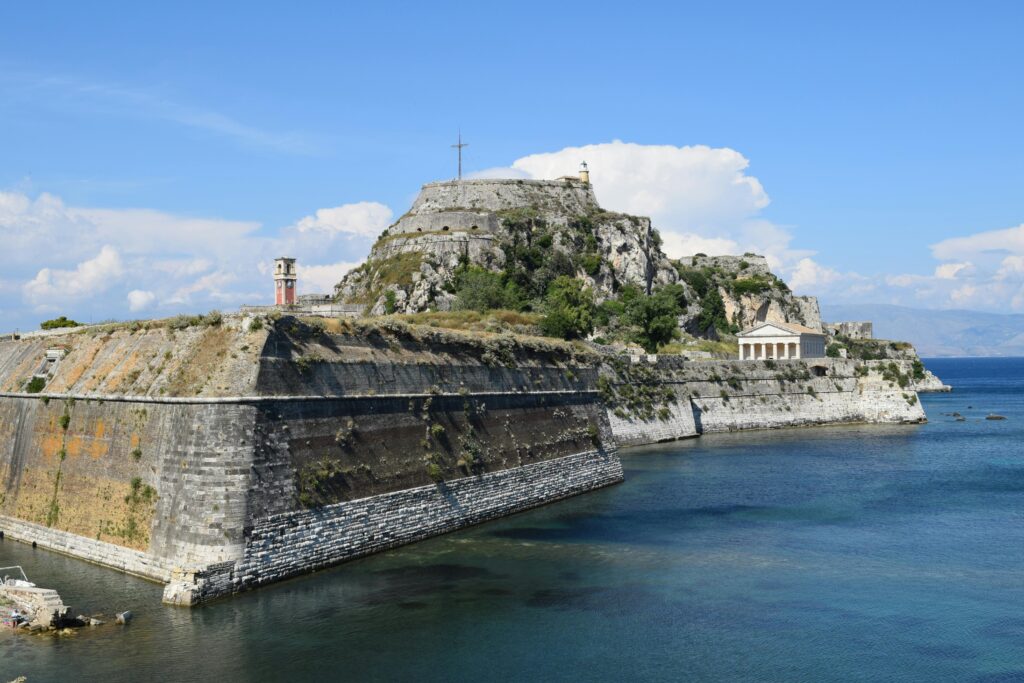
9. Corfu
Corfu, located in the Ionian Sea, is known for its lush landscapes, Venetian-influenced architecture, and beautiful beaches. Corfu Town, a UNESCO World Heritage site, features the Old Fortress, Spianada Square, and charming alleyways filled with shops and cafes. The town’s architecture reflects centuries of Venetian, French, and British rule, giving it a unique and cosmopolitan character.
The island’s coastline is dotted with picturesque villages like Paleokastritsa, known for its stunning bays, clear waters, and the Monastery of the Virgin Mary, which offers panoramic views and a sense of tranquility. The Achilleion Palace, built by Empress Elisabeth of Austria, is another key attraction, featuring beautiful gardens and stunning views over the island.
Corfu’s countryside, with its olive groves and cypress trees, offers opportunities for hiking and exploring traditional villages. The island’s beaches, such as Glyfada, Sidari, and Kassiopi, provide a perfect setting for relaxation and water sports. Corfu’s unique blend of natural beauty, cultural heritage, and warm hospitality make it a beloved destination for travelers seeking both relaxation and adventure.

10. Nafplio
Nafplio, often described as one of the most romantic towns in Greece, is known for its well-preserved architecture and picturesque streets. Nestled on the coast of the Peloponnese, Nafplio’s history is reflected in its Venetian, Ottoman, and Greek influences. Key attractions include the Palamidi Fortress, which offers panoramic views of the town and the Argolic Gulf, and the Bourtzi Castle, located on a small islet in the harbor.
The charming old town, with its neoclassical mansions, narrow streets, and vibrant squares, is perfect for leisurely strolls. Syntagma Square, the heart of the old town, is surrounded by historic buildings and outdoor cafes, creating a lively atmosphere. Nafplio’s Archaeological Museum and the War Museum provide insights into the region’s rich history.
The nearby beaches, such as Karathona and Arvanitia, offer opportunities for swimming and relaxation. Nafplio is also a gateway to other significant archaeological sites, including the ancient theater of Epidaurus and the ruins of Mycenae, making it an excellent base for exploring the Peloponnese. Nafplio’s blend of history, culture, and natural beauty makes it a captivating destination for visitors seeking a mix of relaxation and exploration.
Click here to view the Top Ten Pilgrimage Sites in Greece
Greece is a land of deep spiritual heritage and sacred pilgrimage sites. From ancient monasteries to revered churches, these destinations offer profound spiritual experiences and a deep connection to faith and history.

